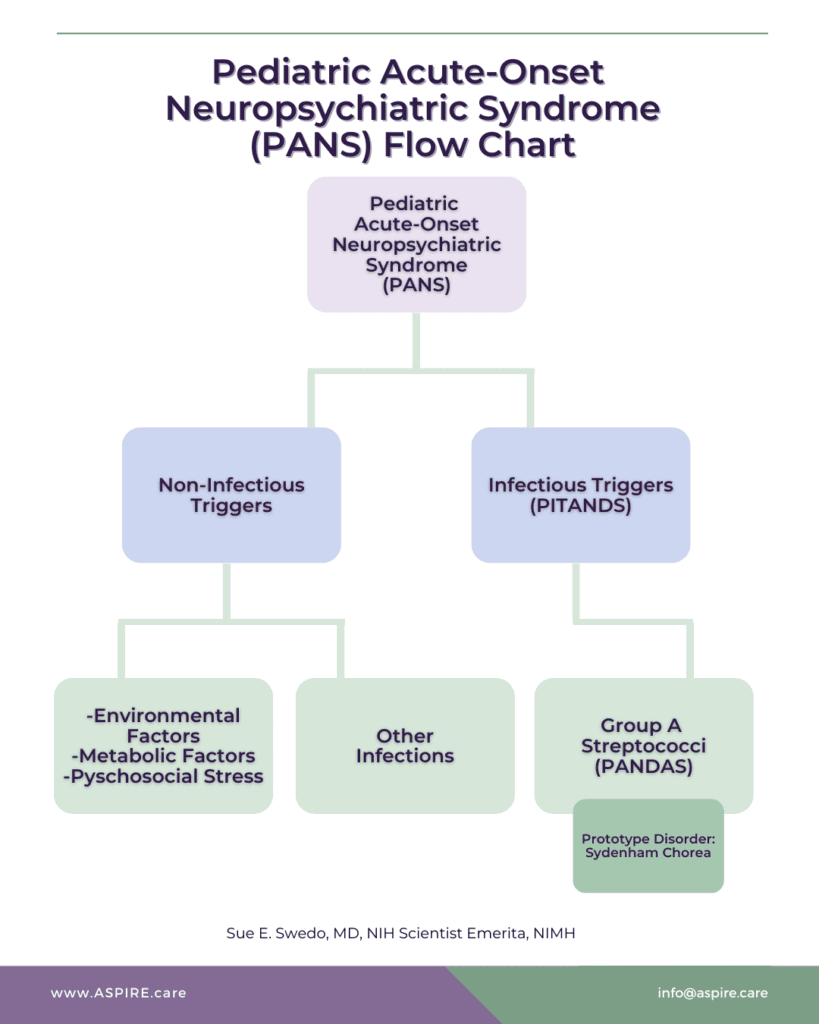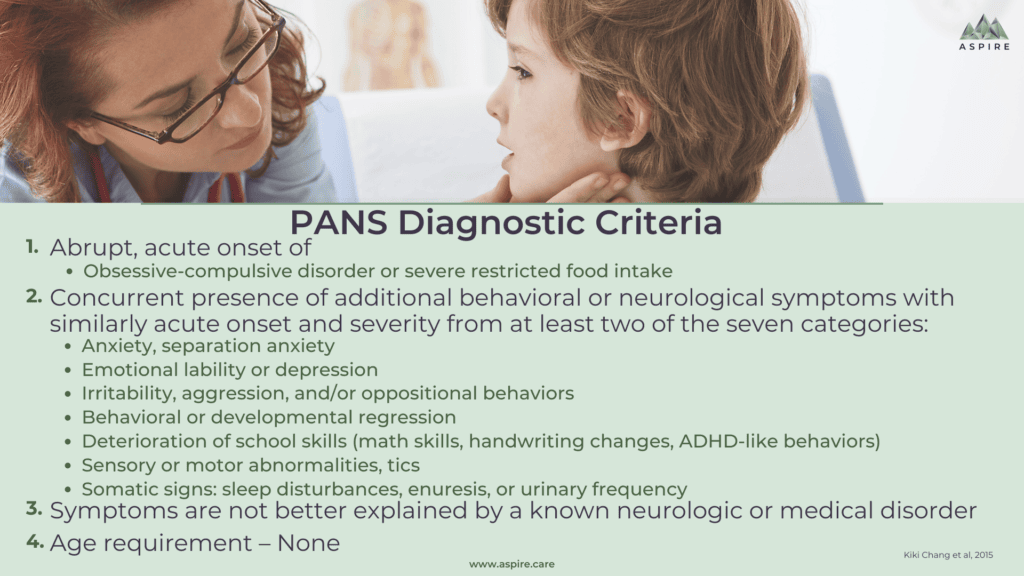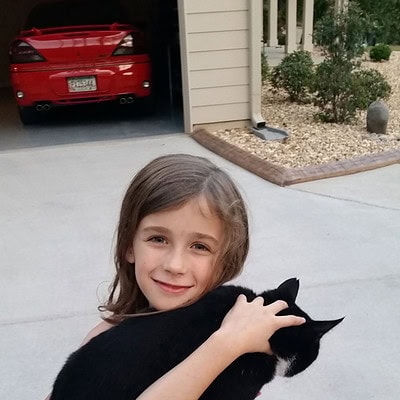PANS/PANDAS are misdirected immune responses that result in newly abrupt onset or worsening of OCD and/or restricted food intake, concurrently with two neuropsychiatric, cognitive, behavioral, or neurological symptoms in seven categories.
What are PANS & PANDAS?
PANS Pediatric Acute-Onset Neuropsychiatric Syndrome
PANDAS Pediatric Autoimmune Neuropsychiatric Syndrome Associated with Streptococcus
PANS is an acronym for Pediatric Acute-Onset Neuropsychiatric Syndrome. PANS is a clinical syndrome defined by the sudden encephalitic-like onset of obsessive-compulsive symptoms and/or severe eating restrictions and at least two concurrent cognitive, behavioral, or neurological symptoms. PANS has multiple etiologies and disease mechanisms with no age restriction for diagnosis.
- Anxiety, Separation Anxiety
- Emotional Lability and/or Depression
- Irritability, Aggression, and/or Severe Oppositional Behaviors
- Behavioral (Developmental) Regression
- Sudden Deterioration in School Performance
- Motor or Sensory Abnormalities, including Tics
- Somatic Signs and Symptoms, including Sleep Disturbances, Enuresis, or Urinary Frequency/Urgency
PANS can be triggered by infections, metabolic disturbances, psychosocial stress, and other inflammatory reactions. Infectious triggers include upper respiratory infections, influenza, recalcitrant sinus infections, mycoplasma pneumonia, and Lyme borreliosis, among others.
PANS and PANDAS require a clinical diagnosis based on a child’s medical history and physical examination. PANS and PANDAS are both a diagnosis of exclusion, meaning symptoms cannot be better explained by another diagnosis. There is no age restriction for a PANS diagnosis; it is not just a pediatric syndrome.
PANDAS, a subset of PANS, stands for Pediatric Autoimmune Neuropsychiatric Syndrome Associated with Streptococcus infections. Group A Strep (GAS) is the incitatory trigger. Sydenham’s Chorea/Acute Rheumatic Fever is the prototype disorder. Please note GAS infections can occur in many parts of the body – not just the throat. The onset of symptoms can occur within days of exposure to or contracting strep or within several months of the inciting infection.
- Presence of OCD and/or tics, particularly multiple, complex or unusual tics
- Age Requirement (Symptoms of the disorder first become evident between 3 years of age and puberty)
- Acute onset and episodic (relapsing-remitting) course
- Association with Neurological Abnormalities
Comorbid neuropsychiatric symptoms are universally present in PANDAS, similar to the diagnostic criteria for PANS with similarly abrupt onset/exacerbation as the primary symptoms of PANDAS. In particular, the somatic symptoms such as urinary frequency, mydriasis, and insomnia, help differentiate PANDAS from Tourette syndrome or non-PANDAS OCD.
I n laypersons terms, it is easiest to understand PANS as an umbrella term for many triggers that create inflammation in the brain, leading to behavioral changes. PANS is a medical disorder with both physical and psychiatric presentations.
n laypersons terms, it is easiest to understand PANS as an umbrella term for many triggers that create inflammation in the brain, leading to behavioral changes. PANS is a medical disorder with both physical and psychiatric presentations.
In technical terms, PANS/PANDAS are misdirected immune responses, often with an encephalitic origin, that result in acute onset of OCD, tics and/or restricted food intake, along with other neuropsychiatric and somatic symptoms. After the initial onset, PANS/PANDAS symptoms follow a relapsing/remitting course. Initial triggers may differ from secondary triggers. During each recurrence, symptoms can worsen, and new symptoms may manifest.
Symptoms can range from mild to severe. In mild cases, children might function well enough to continue to attend school. In severe cases, symptoms can become life-threatening due to extreme food restriction and/or suicidality. Many children with PANS/PANDAS are diagnosed with a psychiatric illness and prescribed psychotropic medications rather than being evaluated and treated for an underlying infection.
According to a consortium of experts convened by the National Institute of Mental Health, appropriate treatment for these disorders is a triad that incorporates psychological support (CBT, ERP and/or psychotropic medication), antimicrobial treatment, and immunomodulation. Read more on PANS PANDAS Treatment.
Learn more about Syndrome vs Disorder and how that applies to PANS and PANDAS.
Learn more about PANS PANDAS Symptoms.
Learn more about PANS PANDAS Diagnosis.
PANS Diagnostic Criteria

We aspire to educate.
Learn about other families whose lives have been affected by PANS/PANDAS — and be inspired to share your own.
